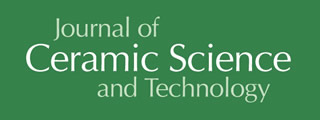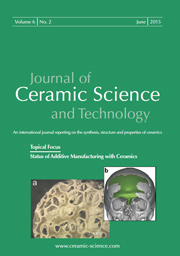Articles
All articles | Recent articles
A Kinetic Study of Limestone Dry Micronization in an Ultra-Centrifugal Mill with Peripheral Comminuting Path
D. Radulović1, D. Božović2, A. Terzić3, M. S. Trumić4, V. Simić5, L. Andrić1
1 Institute for Technology of Nuclear and Other Mineral Raw Materials, Belgrade, Serbia
2 Geological Survey, Podgorica, Montenegro
3 Institute for Testing of Materials IMS, Belgrade, Serbia
4 University of Belgrade, Technical Faculty, Bor, Serbia
5 University of Belgrade, Faculty of Mining and Geology, Belgrade, Serbia
received March 22, 2017, , accepted May 30, 2017
Vol. 8, No. 2, Pages 295-304 DOI: 10.4416/JCST2017-00022
Abstract
Because of its physico-mechanical and physico-chemical characteristics, fine-ground (i.e. micronized) limestone is widely applied in the production of new materials. Limestone can be used as a filler, coating and/or powder in ceramic composites. The effect of its fine micronization depends on the type of equipment used and on the disintegration process. In this study, the emphasis was placed on investigation of the kinetics of the dry micronization milling of limestone in a state-of-the-art ultra-centrifugal mill with a peripheral comminuting path. The efficiency of the ultra-centrifugal mill with a peripheral comminuting path was determined based on a detailed investigation of the limestone dry micronization, which satisfied all the requirements for technological parameters as well as for micronized product parameters. On the basis of the investigation of these parameters and theory of dry micronization conducted in a state-of-the-art mill with use of advanced instrumental techniques for determination and observation of the most significant physical and chemical characteristics, a kinetics model was developed to serve as the basis for quick and effective determination of micronization quality and efficiency. In this paper, the results of grinding in a Retsch ZM-1 ultra-centrifugal mill were analyzed in order to optimize and automate the process of ultrafine micronization.
![]() Download Full Article (PDF)
Download Full Article (PDF)
Keywords
Limestone, fillers for ceramics, mechano-chemical activation, grinding, optimization.
References
1 Gunasekran, S., Aanbalagan, G., Spectroscopic study of phase transitions in natural calcite mineral, Spectrochim. Acta A., 69, [4], 1246 – 1251, (2008).
2 Dollimore, D., Dunn, J., Lee, Y., Penrod, B.: The decrepitation of dolomite and limestone, Thermochim. Acta, 237, [1], 125 – 131, (1994).
3 Yogurtcuoglu, E., Ucurum, M.: Surface modification of calcite by wet-stirred ball milling and its properties, Powder Technol., 214, 47 – 53, (2011).
4 Saeid, D., Elnaz, S.: A modified model of a single rock joint's shear behavior in limestone specimens, Int. J. Min. Sci. Technol., 26, 577 – 580, (2016).
5 De Weerdt, K., Haha, M., Saout, G., Kjellsen, K., Justnes, H., Lotenbach, B.: Hydration mechanisms of ternary portland cements containing limestone powder and fly ash, Cement Concr. Res., 41, [3], 279 – 291, (2011).
6 Felekoglu, B.: Utilisation of high volumes of limestone quarry wastes in concrete industry (self-compacting concrete case), Resour. Conserv. Recy., 51, [4], 770 – 791, (2007).
7 Anastasiou, E., Liapis, A., Papayianni, I.: Comparative life cycle assessment of concrete road pavements using industrial by-products as alternative materials, Resour. Conserv. Recy. 101, 1 – 8, (2015).
8 Guzzo, P.L., Santos, J.B., David, R.C.: Particle size distribution and structural changes in limestone ground in planetary mill, Int. J. Min. Process., 126, 41 – 48, (2014).
9 Mahorous, A.M., Mostafa Tantawi, M., El-Sageer, H.: Evaluation of the engineering properties of some egyptian limestones as construction materials for highway pavements, Constr. Build. Mater., 24, 2598 – 2603, (2010).
10 Cao, W., Liu, S., Feng, Z.: Comparison of performance of stone matrix asphalt mixtures using basalt and limestone aggregates, Constr. Build. Mater., 41, 474 – 479, (2013).
11 Wills, B.: Wills' Mineral processing technology (7th Edition) An introduction to the practical aspects of ore treatment and mineral recovery, Butterworth-Heinemann (Elsevier), Oxford (2006).
12 Schmidt, P., Korber, R.: Planetary mills, Aufbereitungs-Technik, 32, [12], Gesamthochschule Essen, Germany, 1991.
13 Tamai, Y., Mori, S.: Mechanical activation on inorganic powders vibromilling, Z. Anorg. Allg. Chem., 476, [5], (1981).
14 Tkačova, K.: in Mechanical activation of minerals, development in mineral processing, Elsevier, Amsterdam, Vol. 11, 1989.
15 Magdalinović, N.: in Grinding and classification of the mineral raw materials, Belgrade, Serbia, 1991.
16 Terzić, A., Radulović, D., Pezo, L., Andrić, Lj., Miličić, Lj., Stojanović, J., Grigorova, I.: The effect of mechano-chemical activation and surface treatment of limestone filler on the properties of construction composites, Compos. Part B, 117, 61 – 73, (2017).
17 Andrić, Lj., Milošević, V., Petrov, M., Mihailović, S.: Operating technique of mills in the process of micronization milling of alumina, J. Mining Metallur., 41, 27 – 43, (2005).
18 Andrić, Lj., Terzić, A., Petrov, M., Stojanović, J., Kostović, M.: Energy conversion in phosphate ore grain mixture activated via ultra-centrifugal mill, Int. J. Miner. Process., 143, 1 – 11, (2015).
19 Andrić, Lj., Aćimović-Pavlović, Z., Petrov, M., Kostović, M., Jovanović, I., Bartulović, Z.: The type of mechano-activator effect on mechanical activation of fly ash, J. Min. Metall. 48, 13 – 22, (2012).
20 Andrić, Lj., Terzić, A., Aćimović-Pavlović, Z., Pavlović, Lj., Petrov, M.: Comparative analysis of process parameters of talc mechanical activation in centrifugal and attrition mill, Physicochem. Probl. Mi, 50, 433 – 452, (2014).
Copyright
Göller Verlag GmbH


